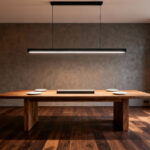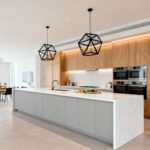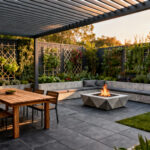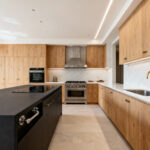You know what people always ask me? It’s not “What color is in right now?” or “What’s the hot new pattern?” The real question, under the surface, is “How can I make my dining room beautiful without it becoming a precious space that nobody can actually use?” They’re thinking about grandkids with sticky fingers, a parent who might need a walker someday, or just the reality of spilling a glass of red wine after a long week.
My whole design philosophy is built on this: a beautiful home has to work for your real, messy, beautiful life. It has to adapt and grow with you. And wallpaper, believe it or not, can be one of the most powerful tools in your arsenal for creating a space that’s not only stylish but also smart, supportive, and ready for whatever comes next. Forget what you think you know about delicate, fussy wallcoverings. Let’s talk about how to do this right.
Strategic Planning & Design Foundations
Before you fall in love with a pattern online, we need to talk strategy. This is the stuff that ensures your wallpaper choice feels intentional and works with your home, not against it. Getting this foundation right is everything.
1. Define Your Dining Room’s Style Vision Clearly
Everyone says you need a “style vision.” That sounds so formal, doesn’t it? What it really means is, “How do you want this room to feel, and who will be using it?” Don’t just think about what it looks like in a magazine; think about what life looks like in that room. Will grandkids be doing homework at the table? Will you be hosting holiday dinners for a big, boisterous family? Do you need a calm retreat or an energizing hub?

Forget Pinterest for a second and just answer those questions. Your vision isn’t about choosing between “mid-century modern” and “farmhouse.” It’s about deciding if you need “forgiving and vibrant” or “serene and sophisticated.” This clarity is your filter. It stops you from buying a gorgeous, delicate silk paper when what you really need is something that can take a hit from a rogue toy car and a splash of spaghetti sauce. It’s about designing for your life, not a fantasy.
Once you have that feeling in mind, we can move on to the single most important factor in how that wallpaper will actually look on your wall: light.
2. Analyze Lighting: How it Transforms Wallpaper Hues
Can we talk about the tyranny of the showroom? A wallpaper sample under perfect, bright, neutral showroom lights tells you almost nothing about how it will look in your actual home. Your dining room has its own unique light—the warm, low glow from the west in the afternoon, the cool northern light in the morning, the artificial light from your chandelier at night. Each one will completely change the color and mood of your wallpaper.

I had a client who fell for a stunning navy blue paper with a subtle gold shimmer. In the store, it was sophisticated and deep. In her dimly lit, north-facing dining room, it looked black. All that beautiful detail was lost, and the room felt like a cave. We had to fix the lighting just to make the wallpaper work. The shortcut: get the biggest sample you can—seriously, ask for a few feet of it—and tape it up. Watch it for a full 24 hours. See it in the morning, at noon, and at night with the lights on. This is the only way to know the truth.
Now that you’re thinking about light, let’s talk about the visual tricks you can play with pattern to change the feel of the room itself.
3. Optimize Scale and Pattern for Room Size
Design magazines love to give you hard-and-fast rules about this. “Small rooms need small patterns.” “Large patterns will overwhelm a space.” It’s mostly nonsense. The real goal is to use pattern to make your room feel intentional. In a small dining room or a little breakfast nook, a bold, large-scale pattern can be incredible. Instead of making it feel cramped, it creates this jewel-box effect, making the space feel special and purposeful.

On the other hand, in a huge, open-concept space, a tiny, busy pattern can just look like visual noise from a distance. That’s where you might want a larger mural or a rich texture to help define and ground the dining area. Here’s my hard-earned lesson: Don’t just think about the walls. Think about the view from the next room. What will that pattern look like from your living room? It needs to be interesting from afar and up close. The right pattern can actually act as a landmark in your home, which is brilliant design for people of all ages, especially if memory or vision is a concern.
With scale decided, let’s get down to the most important practical consideration for a dining room. And I mean the most important.
4. Prioritize Washability and Durability for Diners
This is my pet peeve. People spend thousands on a stunning, hand-printed, delicate wallpaper for the room where they literally serve colorful, stain-prone food and drinks. It’s madness. Your dining room wallpaper must be cleanable. It’s a non-negotiable. This is the single biggest factor that determines whether you’ll love your wallpaper in five years or resent it in five months.

Look for words like “washable,” “scrubbable,” or my personal favorite, “vinyl.” I know, I know, vinyl gets a bad rap, but modern vinyl wallpapers are absolutely gorgeous. They have incredible textures and patterns, but they are also bomb-proof. A client with three young kids chose a beautiful, textured vinyl grasscloth look-alike for their dining area. Within a week, there was a literal handprint of ketchup on it. She wiped it off with a damp sponge. No stain, no damage, no drama. That is the kind of peace of mind that good design gives you. Accessible design is simply good design that anticipates life’s changes, and life includes spills.
Okay, so you’ve found a beautiful, durable option. Now, let’s make sure it doesn’t clash with the furniture you already own and love.
5. Coordinate Wallpaper with Existing Furniture & Decor
Nobody wants to buy all new furniture just to match a roll of wallpaper. Your wallpaper should be the team player that makes everything else look better. The trick is to “echo, don’t match.” Don’t try to find a wallpaper that has the exact shade of blue from your chair cushions. Instead, find one that has a family of blues, or a complementary color like a rusty orange, that makes the blue in your chairs pop.

My best shortcut here is to build a real, physical mood board. Not on Pinterest. Get a swatch of your curtain fabric, a paint chip of your trim color, a photo of your dining table, and your wallpaper samples. Lay them all out together on the table in your dining room. Look at them in the actual light of the room. You’ll see instantly if something feels off. This simple step saves you from the expensive mistake of realizing your new cool-toned gray wallpaper makes your warm wood furniture look cheap and orange.
Now that you have your core elements working together, we can get into a more subtle, but powerful, layer of design: texture.
6. Craft the Desired Mood with Specific Textures
Texture is what makes a room feel rich and layered. It’s the difference between a flat, boring space and one that feels warm and inviting. Think about materials like grasscloth, cork, or even embossed, paintable papers. They add a tactile quality that’s incredibly sophisticated. A beautiful, nubbly grasscloth can make a dining room feel cozy and serene, and it’s fantastic for acoustics—it soaks up sound, making conversation easier and more intimate.

But here’s the universal design check: Is that texture practical for your life? Real grasscloth can be delicate and impossible to clean. A flocked, velvet-like paper is beautiful, but it’s a magnet for dust and not ideal for a family with allergies or a low-maintenance lifestyle. The shortcut is to look for performance-grade textures. Many companies now make incredibly realistic vinyl versions of grasscloth and linen that give you that wonderful textured look with the durability we talked about earlier. You get the high-end feel without the high-maintenance headache.
Selecting Patterns, Colors & Material Types
Alright, the foundation is set. Now for the fun part: picking the actual paper. Here’s how to narrow down the choices to find something that is not only beautiful but also built to last.
7. Choose Durable Wallpaper Materials for High-Traffic Dining
I’m going to say it again because it’s that important. Durability is everything in a dining room. If you remember one thing from our chat, let it be this. When you’re shopping, you need to be looking for materials that can stand up to real life. This is where you might see codes like “Type I” or “Type II.” Don’t let that intimidate you. “Type II” is basically commercial-grade vinyl, and it’s your secret weapon. It’s designed for hotels and restaurants, so you know it can handle your family dinner.

A lot of the most beautiful and stylish wallpapers on the market now are non-woven or solid vinyl. They’ve come a long, long way from the shiny, plastic-looking papers of the ’70s. These materials are breathable, which helps prevent mildew, and they are often strippable, meaning they come off in full sheets when you’re ready for a change, without destroying your walls. Investing in a durable material from the start saves you so much money and heartache in the long run.
Now that you’ve got a tough-as-nails material, let’s put it to work defining the very shape and flow of your space.
8. Select Patterns That Expand or Define Dining Spaces
Wallpaper is a kind of magic. You can use it to visually stretch, shrink, or define a space. This is incredibly useful, especially in modern homes with open-concept layouts. A bold, captivating wallpaper on a single wall behind your dining table can create a “room” where one doesn’t physically exist. It acts as an anchor, a destination. This isn’t just a design trick; it’s a fantastic tool for universal design. It provides a clear visual cue that helps everyone, from a child to an older adult with cognitive decline, understand the home’s layout.

For small dining rooms, a pattern with vertical stripes or a design that draws the eye upward can create a sense of height and airiness. A mural with a receding landscape can add an incredible illusion of depth. But don’t be afraid to go bold in a small space! I once used a deep, dramatic botanical mural in a tiny dining nook. Instead of making it feel smaller, it made it feel like an immersive, intentional escape. The key is to commit. A timid pattern often has less impact than a bold one.
Let’s move from pattern to the emotional core of the design—color—and how it can influence more than just the look of your room.
9. Understand Color Psychology for Dining Ambiance
Color doesn’t just decorate a room; it changes how you feel inside it. This is especially true in a dining room. Warm colors like reds, oranges, and earthy terracottas are known to be appetizing and to stimulate conversation. They’re great for creating a vibrant, energetic space where you want people to gather and talk. On the flip side, deep greens and blues can create a sense of calm and formality, perfect for a more serene, sophisticated dining experience.

But you have to think about the people in the room. An extremely bright, stimulating red might be great for lively dinner parties, but it could be overwhelming for a child on the autism spectrum or someone who prefers a calmer environment. A good approach is to find a wallpaper that balances these things. Maybe it’s a deep teal with flashes of warm coral. Or maybe the color is deployed with contrast in mind. For someone with low vision, a wallpaper that has a strong contrast with the floor and furniture makes the space much easier and safer to navigate.
Building on color, let’s revisit texture and how it can add that final layer of sophistication.
10. Leverage Textured Wallpapers for Sophisticated Depth
Flat walls are fine, but textured walls have a soul. A wallpaper with a tactile quality, whether it’s a subtle linen weave or a dramatic embossed pattern, plays with light in a way that paint never can. It adds a layer of shadow and highlight that gives the walls a sense of depth and life. As I mentioned, it also helps with sound, deadening echo and making the room feel more intimate and comfortable for conversation.

Here’s a shortcut to making texture look incredibly high-end: light it properly. Don’t just rely on the overhead chandelier. Add wall sconces or picture lights that “graze” the wall. This side-lighting will pick up every little detail of the texture and create a beautiful, dramatic effect that makes the wallpaper the star of the show. Just remember to balance it. If you have a highly textured wallpaper, maybe keep your drapery and chair fabrics simpler to give the eye a place to rest.
Now, what if you love pattern so much you don’t want to choose just one? Let’s talk about how to mix them like a pro.
11. Mix Complementary Patterns Without Overwhelm
Mixing patterns feels intimidating, but there’s a simple formula: vary the scale and unite with color. Start with your “hero” pattern—this will be your wallpaper, the largest and boldest pattern in the room. Then, choose a secondary pattern (maybe for your chair cushions or rug) that’s about half the scale. Finally, add a third, small-scale accent pattern (perhaps on a throw pillow or in a piece of art).

The glue that holds it all together is a shared color palette. As long as all three patterns share at least one or two common colors, they’ll feel connected, not chaotic. I learned this the hard way on an early project where I tried to mix three bold, same-scale patterns. It was a visual train wreck. The client walked in and you could just see the anxiety on her face. Now, I always add plenty of “breathing room” with solid colors—the trim, the ceiling, a solid tablecloth—to balance out the patterns and create a look that’s dynamic, not dizzying.
With all these modern ideas, it’s also important not to forget the story your house is already telling.
12. Align Wallpaper Choices with Room’s Architectural Era
This doesn’t mean you have to create a museum. If you live in a 1920s Craftsman, you don’t have to use a stuffy, period-perfect William Morris print (unless you love it!). But acknowledging your home’s bones creates a sense of harmony. A stark, minimalist geometric might feel jarring in a curvy Victorian, just as an ornate damask might look out of place in a sleek, mid-century modern home.

The best approach is to find a modern interpretation. Look for a wallpaper that gives a nod to the era. For that Craftsman home, you could choose a modern botanical print with the same earthy color palette and respect for nature found in the Arts & Crafts movement. This honors the home’s history while still feeling fresh and personal. It makes the design feel like a thoughtful conversation between the past and the present, rather than a shouting match.
Innovative Application & Layout Concepts
You’ve chosen the perfect paper. Now, let’s think beyond just slapping it on all four walls. This is where you can get really creative and make a huge impact with less material and effort.
13. Design an Impactful accent wall for Dining Focus
The accent wall gets a bad rap sometimes, but when done right in a dining room, it’s brilliant. The key is to choose the right wall. It should be the first wall you see when you walk in, or the wall that sits behind your dining table. It’s your room’s natural focal point. This isn’t just for looks; it creates an instant visual anchor, which is especially helpful in an open-concept space.

My favorite shortcut for making an accent wall feel integrated is to pull a secondary color from the wallpaper pattern and paint the other three walls in that shade. This makes the design feel cohesive and intentional, not like you just ran out of wallpaper or couldn’t decide. A bold floral or a dramatic mural on one wall, supported by softer, complementary walls, creates a confident and inviting space without overwhelming the senses.
If an accent wall feels bold, our next idea is for the truly daring. It’s time to look up.
14. Boldly Wallpaper Your Ceiling for Grandeur
The ceiling is the ‘fifth wall,’ and it’s the most neglected surface in design. Wallpapering a ceiling is an incredibly dramatic, sophisticated move that can completely transform a room. In a dining room with tall ceilings, a dark, moody pattern overhead can make the space feel cozier and more intimate. In a room with lower ceilings, a light-colored paper with a metallic or pearlescent sheen can bounce light around and create a feeling of height and openness.

This is a job I almost always recommend hiring a professional for. It’s physically demanding and getting the patterns to line up perfectly while working against gravity is a true skill. But the result? A jaw-dropping statement that feels incredibly luxurious and custom. I once used a dreamy, cloud-mural wallpaper on the ceiling of a formal dining room. It felt like you were dining in the open air. It was pure magic.
For a move that’s a little less daring but just as chic, let’s talk about finding the perfect partnership between wallpaper and paint.
15. Seamlessly Combine Wallpaper with Painted Walls
This is one of my all-time favorite strategies because it’s both beautiful and incredibly practical. The classic application is to install a chair rail and use wallpaper on the top portion of the wall, with a durable, scrubbable paint on the bottom. This gives you the best of both worlds: the pattern and beauty of wallpaper, placed safely out of the primary “impact zone” of chairs, scuffs, and spills.

This is universal design in action. The painted lower portion is tough and easy to touch up—perfect for a high-traffic area. The wallpaper above adds personality without the risk of being damaged. You can also reverse this for a more modern, unexpected look. It’s also a fantastic budget-saver, as you’re only using half the amount of wallpaper. It’s a smart, stylish compromise that doesn’t feel like a compromise at all.
From large wall sections, let’s zoom in on the smaller architectural details that can pack a big punch.
16. Incorporate Wallpaper into Niche or Challenging Areas
Do you have a built-in hutch, a recessed bookshelf, or an awkward little alcove in your dining room? Don’t ignore it—celebrate it! Lining the back of these spaces with a pop of wallpaper is like adding a surprise lining to a beautiful coat. It turns a simple architectural feature into a curated, jewel-box moment. It’s also the perfect way to use a remnant of a very expensive or bold wallpaper that you love but couldn’t afford to put everywhere.

This technique is incredibly forgiving for a DIYer because you’re working with small, manageable pieces. A little pop of a botanical print behind your white dishes or a fun geometric behind your collection of glassware adds instant depth and personality. It draws the eye in and makes the whole room feel more custom and thoughtfully designed. It’s a small detail with a massive impact.
You can take that idea a step further by creating your own architectural features with frames.
17. Frame Dining Spaces with Decorative Wallpaper Panels
If you love the look of wainscoting but don’t have it, you can create a similar effect with simple wood trim from the hardware store. By creating large “picture frame” boxes on the wall with molding and then wallpapering inside them, you get a super elegant, custom look for a fraction of the cost. The wall outside the panels can be painted in a coordinating color, making the wallpaper panels feel like built-in works of art.

This is another brilliant solution for those who feel intimidated by a full-room installation. It breaks the project down into smaller, more manageable sections. I had clients who fell in love with a breathtaking, hand-painted chinoiserie panel that cost a fortune. We bought a single panel and framed it on their main dining wall. It became the stunning centerpiece of the room, giving them the high-end look they craved in a way that fit their budget.
Smart Installation & Longevity Tips
You’ve done the hard work of planning and selecting. Now it’s about execution. Getting the installation and maintenance right is what protects your investment and ensures your beautiful new walls stay beautiful.
18. Master Wall Preparation for Flawless Adhesion
I cannot stress this enough: Your wallpaper job is only as good as the wall underneath it. Everyone wants to skip this part and get to the pretty patterns, but it’s the most critical step. You have to wash the walls to get rid of any dust or grease. You have to fill every little nail hole and sand it smooth. And you must use a wallpaper-specific primer, often called “sizing.”

I once had to rescue a DIY project where the homeowner hung expensive wallpaper directly onto raw drywall. The drywall just sucked up the paste unevenly, creating a map of bubbles and bald spots. It all had to be torn down, ruining the paper. Primer creates a sealed, uniform surface so the paste can grip evenly. It’s an extra day of work, but it’s the difference between a job that lasts fifteen years and one that fails in fifteen days.
Once your walls are perfect, you need the right gear to get the job done without losing your mind.
19. Assemble Essential Tools for Smooth DIY Installation
Trying to hang wallpaper with a pair of kitchen scissors and a credit card to smooth it out is a recipe for absolute disaster. Setting yourself up with the right tools isn’t being fussy; it’s being smart. It saves you time, frustration, and wasted wallpaper. You need a long metal straight edge for cutting, a sharp utility knife with lots of snap-off blades (a dull blade will tear your paper), a wallpaper smoother, and a small seam roller.

The seam roller is the pro tool that most DIYers skip, and it’s a huge mistake. Gently rolling your seams after they’re up ensures they are perfectly flat and adhered, making them virtually disappear. All these tools can be bought in a simple, inexpensive kit. Spending $30 on the right tools will save you from ruining hundreds of dollars worth of wallpaper. Trust me on this.
Of course, the smartest tool of all can sometimes be your phone—to call a professional.
20. Decide When Professional Wallpaper Installation Saves Time
There is zero shame in hiring a professional. In fact, it’s often the smartest and most economical decision you can make. If you’ve chosen a very expensive paper, a complicated pattern (like a mural that needs perfect alignment), or if your walls are in rough shape, a pro is your best friend. They will get the job done in a fraction of the time, with almost no wasted material.

Think about the true cost of DIY. It’s not just the materials; it’s your time. How many weekends will it take you? What’s your frustration worth? A client once told me, “I could spend three Saturdays fighting with this, or I could pay someone and spend those three Saturdays with my kids.” For them, the choice was obvious. An experienced installer makes it look easy because they’ve already made all the mistakes and learned from them on someone else’s walls. Sometimes, that’s an investment worth making.
Finally, once those beautiful walls are up, here’s how to keep them looking perfect for years to come.
21. Maintain Your Dining Room Wallpaper for Enduring Beauty
This part is easy, but it has to be consistent. The biggest enemy of wallpaper over time is dust and grime. The best thing you can do is gently vacuum your walls with a soft brush attachment every few months. This prevents dust from settling into the texture or dulling the colors. For any spills or splatters, address them immediately.

Always follow the manufacturer’s cleaning instructions. For a “washable” paper, you can use a slightly damp sponge with a drop of mild dish soap. For “scrubbable” vinyl, you can be a bit more robust. But always test any cleaning solution on a hidden spot first—behind a piece of furniture or on an extra scrap. Never use harsh or abrasive cleaners. Gentle, consistent care is all it takes to keep your investment looking brand new.
A Backdrop for a Beautiful Life
So, you see? Choosing dining room wallpaper isn’t just a decorative choice. It’s an act of designing for your real life. It’s about creating a backdrop that can handle the joyful chaos of a family dinner and still feel elegant and special. It’s about building a space that feels like you, that supports you, and that can adapt as your life changes.
Don’t be afraid of pattern or color. Don’t be intimidated by the process. By thinking through the foundation, choosing smart, durable materials, and applying it with intention, you can create a dining room that’s not just a showpiece, but the true, beautiful heart of your home. The perfect setting for your next unforgettable meal is just a roll away.






